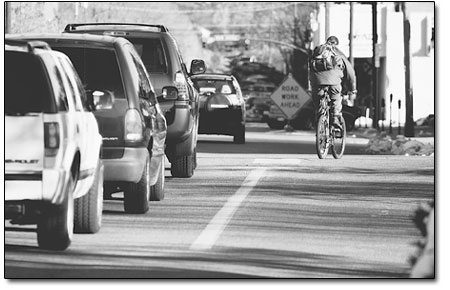| ||
| Safe passage Coalition works to make roads and streets accessible to all users SideStory: Completing the streets
by Will Sands Durango and La Plata County are taking a broader view of streets, roads and transportation corridors. The Safe Roads Coalition is partnering with Trails 2000 and local municipalities to ensure that pedestrians, cyclists and cars can all travel safely and in a way that enhances the health of the community. The Safe Roads Coalition was founded in 2005 as a volunteer effort to promote safe roads, pathways and sidewalks for all users in La Plata County. Improved pedestrian safety and enhanced opportunities for multi-modal transportation, including bicycling, are top priorities for the group. This week, the coalition took its mission to the next level, moving beyond an all-volunteer effort. In partnership with Trails 2000 and the Iron Horse Bicycle Classic, the group hired Kendra Holmes as the new Safe Roads Coalition coordinator. The former director of IHBC and member of Bicycle Colorado explained that roads are too often considered the exclusive realm of the automobile. “One piece that always seems to be missing is making sure that our roads are accessible for all users, including pedestrians, kids and people trying to get to trailheads,” she said. “One of the big things our area is lacking is connectivity between the pavement and trails.” Safety for all users of the region’s roads and highways, whether they are cycling, walking or driving, is also a primary focus for the group, she said. To this end, she will be working with the City of Durango, La Plata County and state agencies to help bring a broad view to transportation in the region. “The city, county and department of transportation are all very to open to exploring responsible ways to bring a ‘complete streets’ philosophy to roads in the area,” she said. “We’re looking at ways to include all users into the public right of way.” Holmes will report to Trails 2000 in her push to provide transportation solutions that are not focused solely on automobiles. The local trails advocacy group is involved for a variety of reasons, according to Executive Director Mary Monroe. “If you look at the whole idea of health and quality of life, getting out of your car and being able to connect hard and soft surface corridors is crucial,” she said. “How do we go from concrete to dirt in a more cohesive way? How do we pursue healthy and alternative transportation in this community?” Safety and accessibility are also paramount issues for Trails 2000 and keystones to opening the door to more alternative travel in La Plata County. “In order to be proactive, we have to think about safety,” Monroe said. “If we really want our kids to walk or ride to school or our employees to ride their bikes to work, we need safe and accessible routes. That issue of safety cuts across all user groups.” Safe and accessible routes are priorities that have found their ways into the Durango Comprehensive Plan and the La Plata County Strategic Plan. Both plans outline transportation fixes and trail builds that are community priorities. With this in mind, the Safe Roads Coalition hopes to take the next steps. “We’re basically trying to move along the priorities the community has already asked for,” Monroe said. Holmes added that community sentiment is strongly in favor of broadening transportation alternatives, and that numerous volunteer efforts led the community to the current stepping-off point. “It’s not just the cyclists,” she said. “It’s the pedestrians; it’s the seniors; it’s the moms and the kids; and it’s the drivers. Everyone is coalescing and saying there is a problem and asking what can we do to fix it.” The Animas Valley has risen to the top of the coalition’s list of areas in need of fixes. The group is currently looking at ways of address conflicts on County Roads 250 and 203, which are popular both as transportation and recreation corridors. “It doesn’t always have to be about laying down more asphalt. There are a variety of things that can be done to accommodate all users that don’t have to cost much more,” said Holmes, who suggested restriping and tightening the existing lanes as one of those options. The Safe Roads Coalition, Trails 2000, Healthy Lifestyle La Plata and the 9-R School District also recently submitted a grant application to encourage safe routes between homes and schools. The groups are hoping to start with Park Elementary and then look at other schools and corridors. “Back in the ’70s and ’80s, everyone used to bike or walk to school,” Holmes said. “If we can start to change the mindset today, this is one way to enhance people’s sense of community.” As parallel efforts, the coalition and Trails 2000 are working to have Durango designated a “Bicycle Friendly Community” and partnering with the Colorado Department of Transportation on extending the Animas River Trails east and west along U.S. Hwy. 160. Holmes concluded that the hope is that these pushes for safe roads and alternate transportation will get Durango ahead of the eight ball both locally and nationally. “Durango is really on the forefront of becoming a transportation leader,” she said. “We’re starting to show how these kinds of collaborative efforts can enhance and make this community even more sustainable.” For more information on the Safe Roads Coalition, visit www.saferoadscoalition.org. •
|
In this week's issue...
- December 18, 2025
- Let it snow
Although ski areas across the West have taken a hit, there’s still hope
- December 18, 2025
- Look, but don't take
Lessons in pottery theft – and remorse – from SW Colorado
- December 11, 2025
- Big plans
Whole Foods, 270 apartments could be coming to Durango Mall parcel


